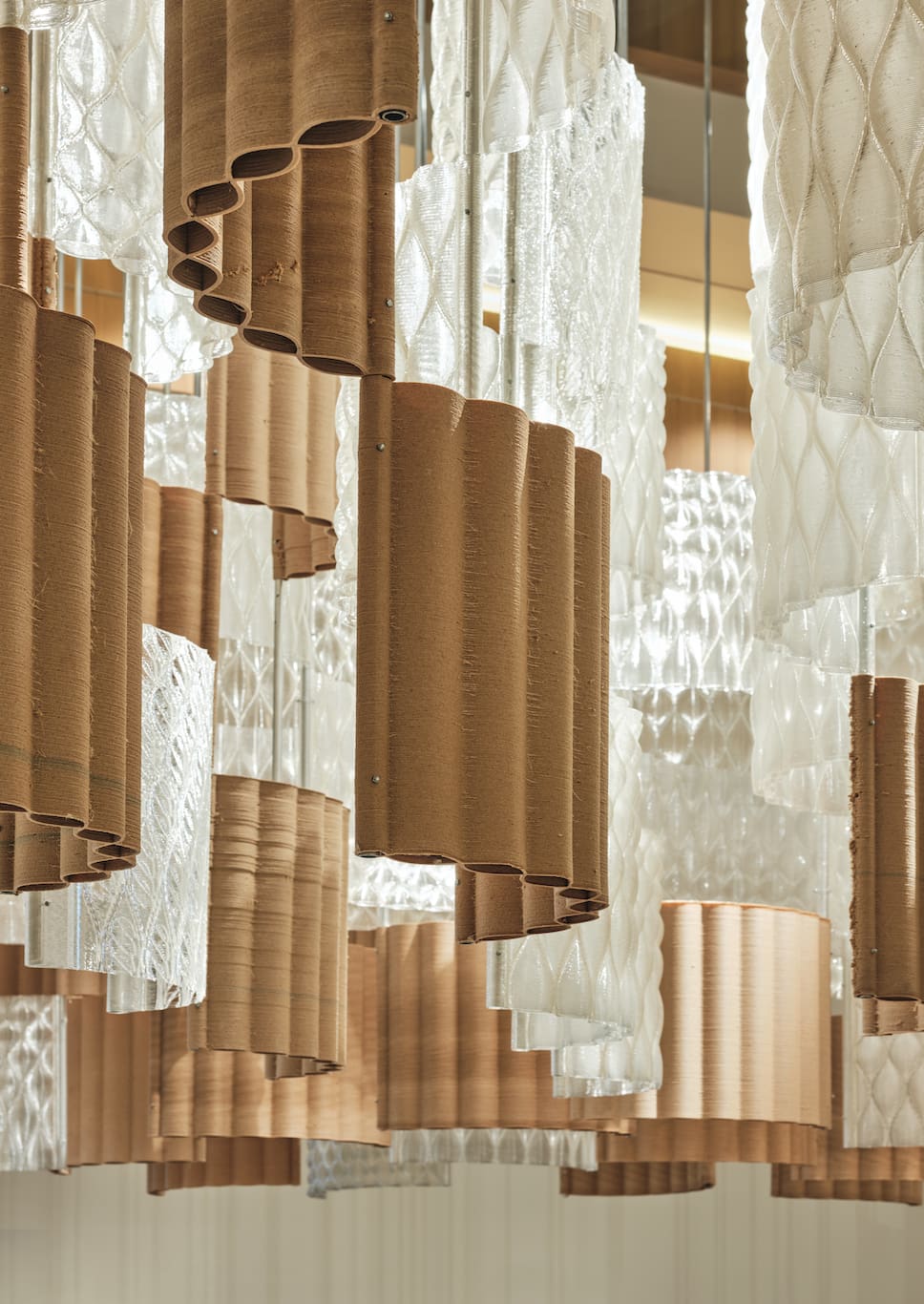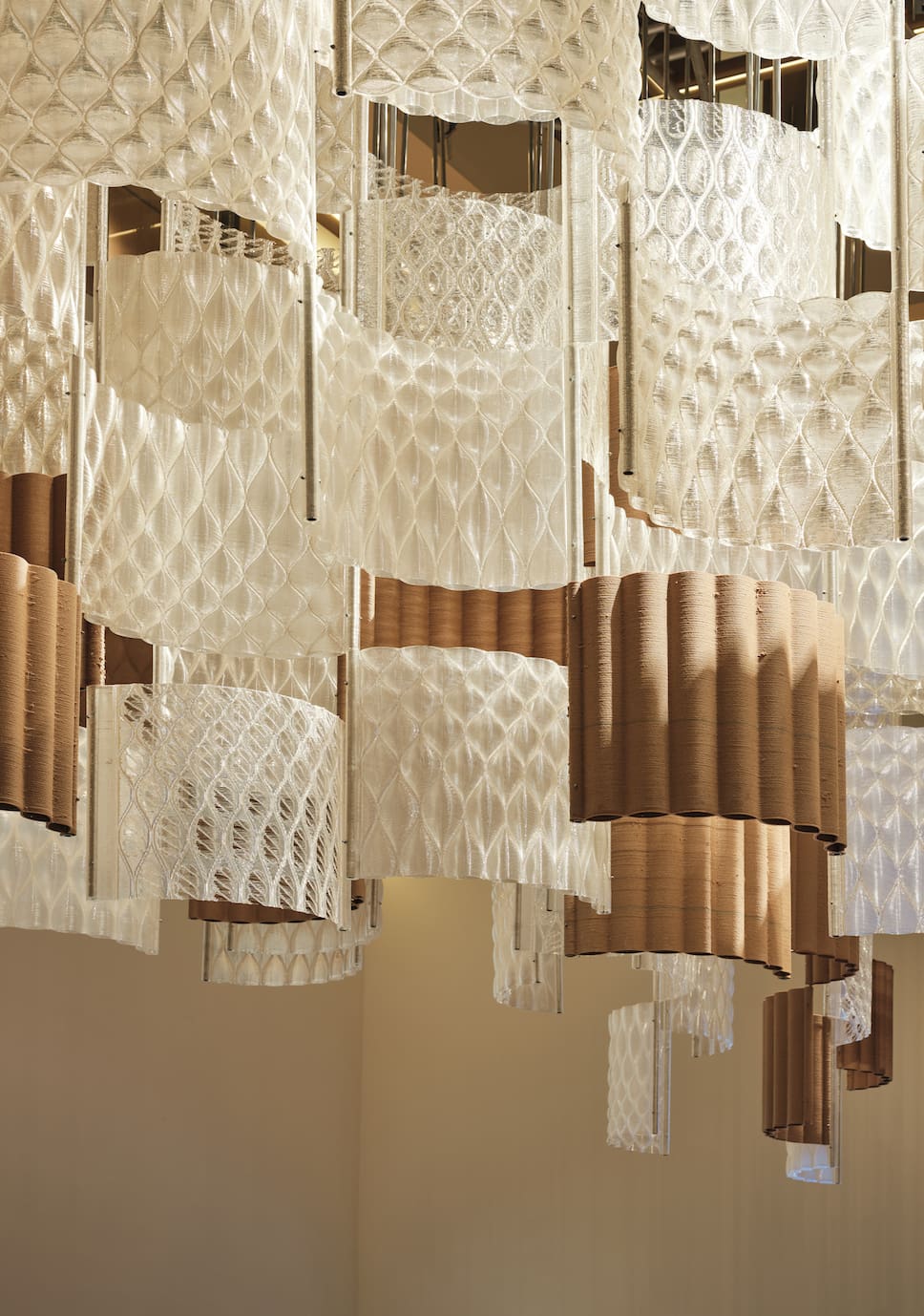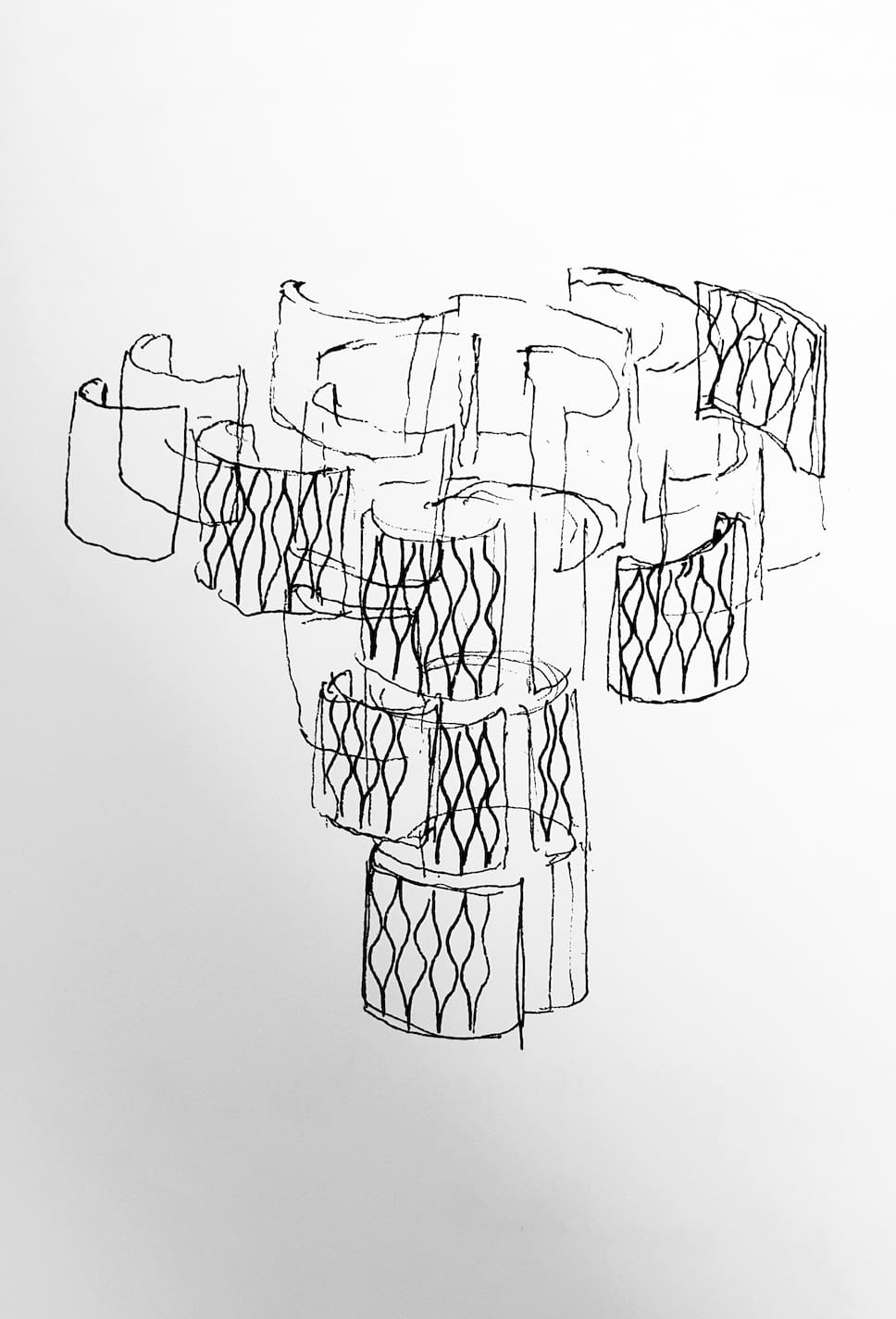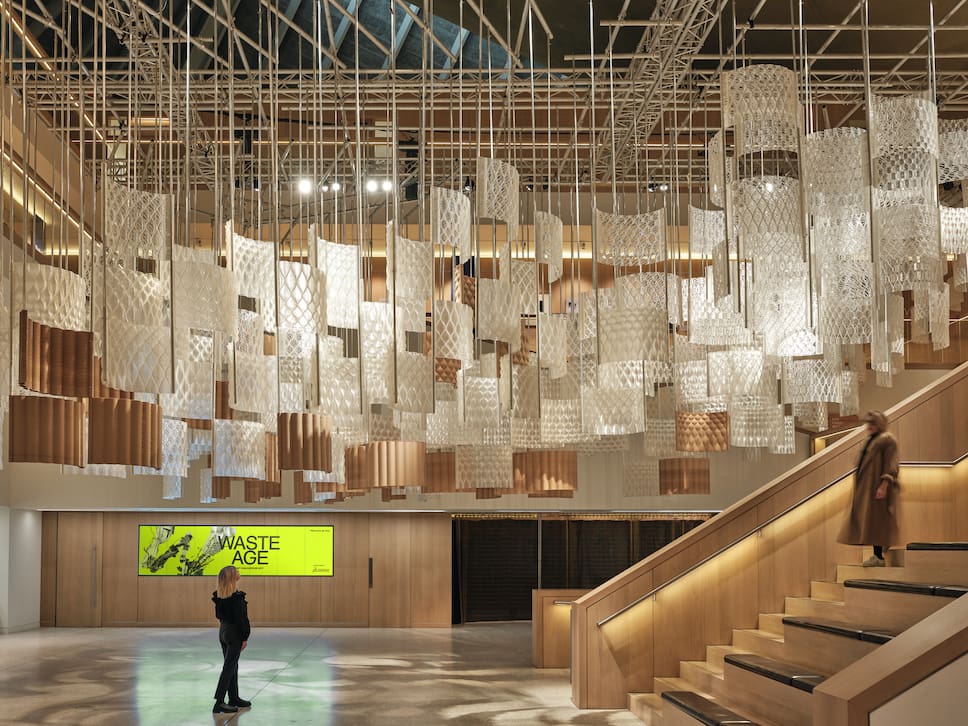
The sustainable Aurora installation by Arthur Mamou-Mani and Dassault Systèmes is being showcased in London’s Design Museum, coinciding with the ‘Waste Age: What Can Design Do?’ exhibition.
Opening the Waste Age exhibition, the large-scale and interactive Aurora Installation is displayed in the museum’s atrium and “signals the end of the take-make-waste era”, according to architect Arthur Mamou-Mani. Working closely with Anne Asenio, Vice President of Design Experience at Dassault Systèmes, they have brought design and technology together in conceiving this installation using PLA plastics and wood pulp to show how a new and sustainable building material could be conceived.
To find out more about this exciting launch, we caught up with Arthur Mamou-Mani and Anne Asenio to get their perspectives on the installation design process and why designers should be questioning their environmental impact….
Arthur Mamou-Mani tells us that his initial idea for Aurora came from something quite simple – a small, dried piece of cactus in his office. “It has these beautiful flowing lines, which is the fibrous nature of the structure. We have a lot of natural objects in the studio or things we find in nature that inspire us, and we turn these into what we call parametric models. The models are based on rules which emerge and develop themselves, iterated through a constant variation like nature.”
The name ‘Aurora’ celebrates a new dawn, and is an installation that “rises to the ceiling and catches the light”. It also “embodies the new dawn of materials, as visitors learn how sugar cane waste can be transformed into plastic and then recycled again with a plastic crusher. They will see the project disappear and come back to life, in this new era of circular, regenerative, and resilient design,” he continues.
Working with the 3D design and engineering software by Dassault Systèmes, means the installation has become more than simply a piece of art. “By questioning every aspect of its production and lifecycle, from a detailed assessment of the environmental impact of the material through to the possibilities for disassembly and reuse, we wanted to bring the audience along a journey that questions how we may design and create habitats in the future,” says Anne Asenio.
How does the innovative design and fabrication process embrace the idea of ‘regeneration’?
Arthur: “Durative design is when you don’t necessarily know the full outcome of your idea, but you trust the rules to develop interesting, unusual form that will surprise even quote and quote, the designer. The idea of a regeneration is also the idea that from one project to the next, from one iteration to the next those regenerations could be requestioned. So that it becomes not just generative in its geometry, but also it could regenerate more ideas, almost like a fractal of ideas. So one idea generates another one, which generates another one. And so, you know, Aurora has many layers that can be explored.”
Anne: “Currently, when we are designing we basically extract from the natural capital, so what you are making you are ultimately disposing. This is following a very linear process that is completely unsustainable. What we want to do is basically embrace the circular design principles where we are designing with details in mind. Regeneration involves selecting the right materials that have an opportunity to be regenerated, reused, recycled, repurposed, and redesigned.
If you want to design for the regeneration you first need to choose the right material by testing materials that have different structural capacity, and select the best one with this end in mind. Secondly, assembly and disassembly. When you assemble a design, you may think about its disassembly – whether it’s going to be very easy to take it apart and recycle within the system or reuse or repurpose. This is the power of the virtual. The result is that the designers basically will have full traceability of the final impact and that’s what we call regeneration.”

What experience and knowledge do you hope visitors will take away from the interactive installation?
Arthur: “I hope they are intrigued and I hope they will think why is this the way it is? And they will start looking into maybe the materials and wonder what kind of material can do something like this.”
Anne: “We wanted to create something that makes people first have an emotional reaction, then a moment of wonder, and a moment of reflection. It’s really a question of empowering people from a cultural standpoint because the issues that we are facing cannot be resolved by technology. They may be resolved by creativity, by the changing of behaviours, so we want people to take time to reflect on what is happening and look at Aurora as an interesting experimentation.”
The Design Museum’s Waste Age exhibition coincides with the COP26 in Glasgow. Do you believe worldwide governments are committed and serious about delivering on important sustainable goals?
Arthur: “I think we always kind of expect the government to do the work, but the government is us, you know, or at least as a democracy we can impact things that we do in the things we purchase, in the way we think, in our curiosity. So as much as I would love the government to take action, I’m not one to point fingers. I’d much rather that we look at ourselves and what it is that we can change.”
Anne: “As a designer, I strongly believe that design has a very important place within all the 17 sustainable goals achievements. By supporting creative industry we may shift our surroundings, but more importantly shift our behaviours. COP26 is not just about policy making, it is about embracing circular design and circular economy principles, putting design at the core and enabling and empowering designers and architects.”
Looking to the future, what are you hoping your continued collaboration will bring to the design industry?
Arthur: “I really enjoyed being able to work with Dassault Systèmes and the discussions that went way beyond the piece of art. It was really about questioning the industry and the impact we can have as designers and software creators. And we can all have a huge impact on the carbon footprint that we all have.
I think we can all have these bigger discussions in any jobs that we do. So, I really look forward to taking every piece of knowledge that we’ve built together as a team and taking it a little bit further, into things that are closer to people’s lives. Maybe a bit more at a domestic scale. Or maybe in a way in the office, or I would love for this piece to travel around and become maybe a more applied project.”
Anne: “We want to empower the artists that we work with. For us this collaboration is shaping the way we think and the way Arthur Mamou-Mani is practicing his design and approach. He now knows that he can basically have a much broader ecosystem of expertise, of solutions, of technology, of people he can trust, people he can work with; there are a lot more ambitious projects that depict the regeneration topic.”
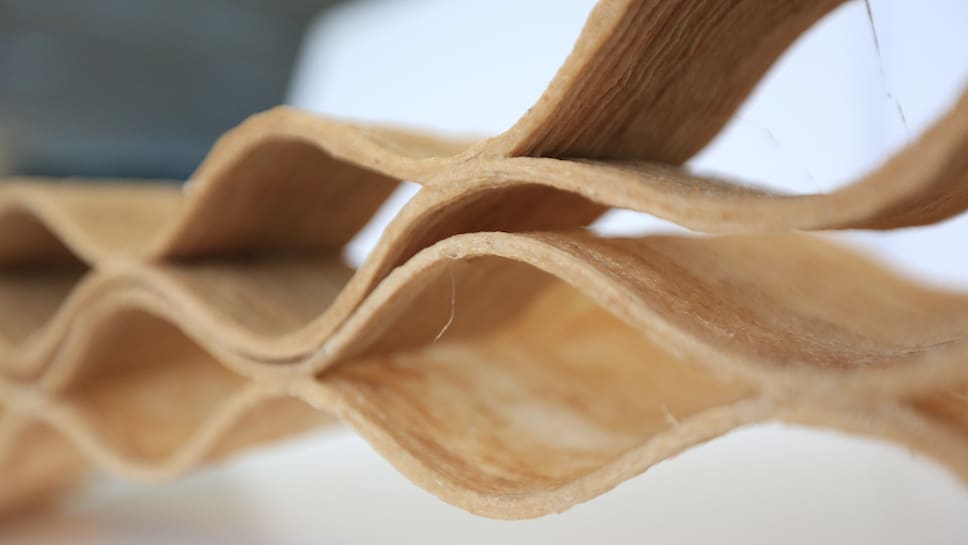
Aurora will be showcased at the Design Museum in London from 23rd October – 14th November 2021, to accompany the ‘Waste Age: What Can Design Do?’ exhibition (until 20th February 2022).
Discover more diary dates and design stories on enki.
